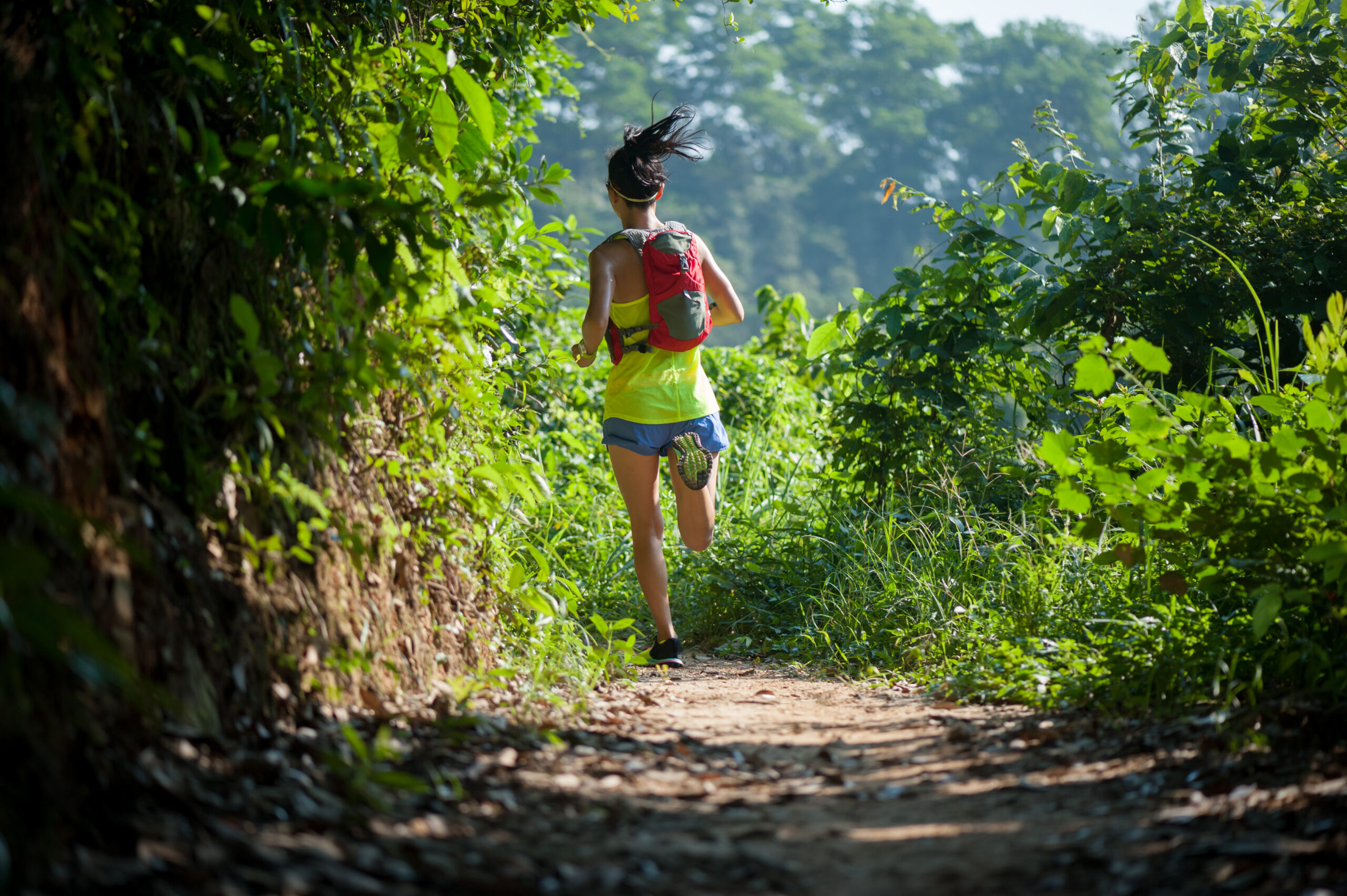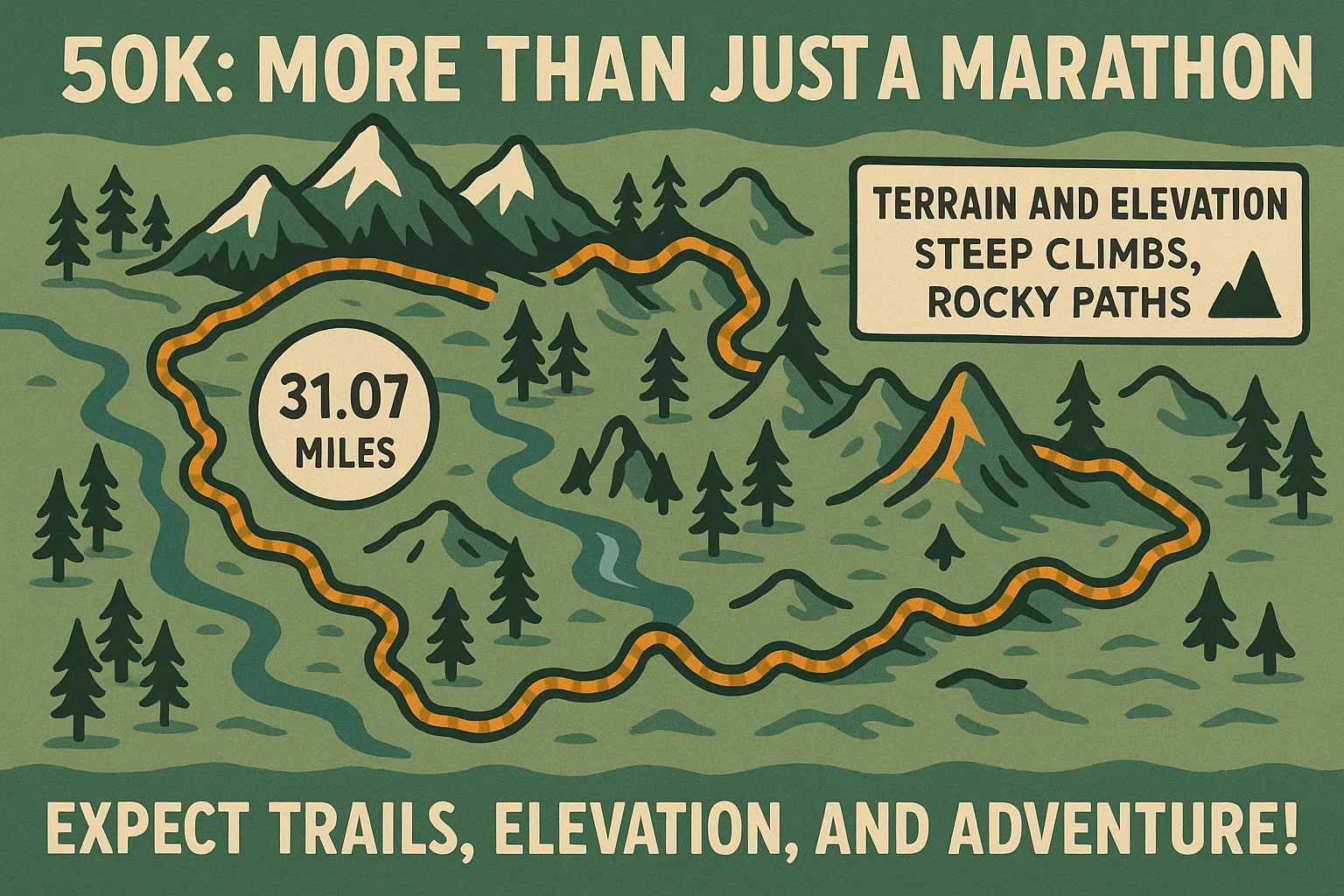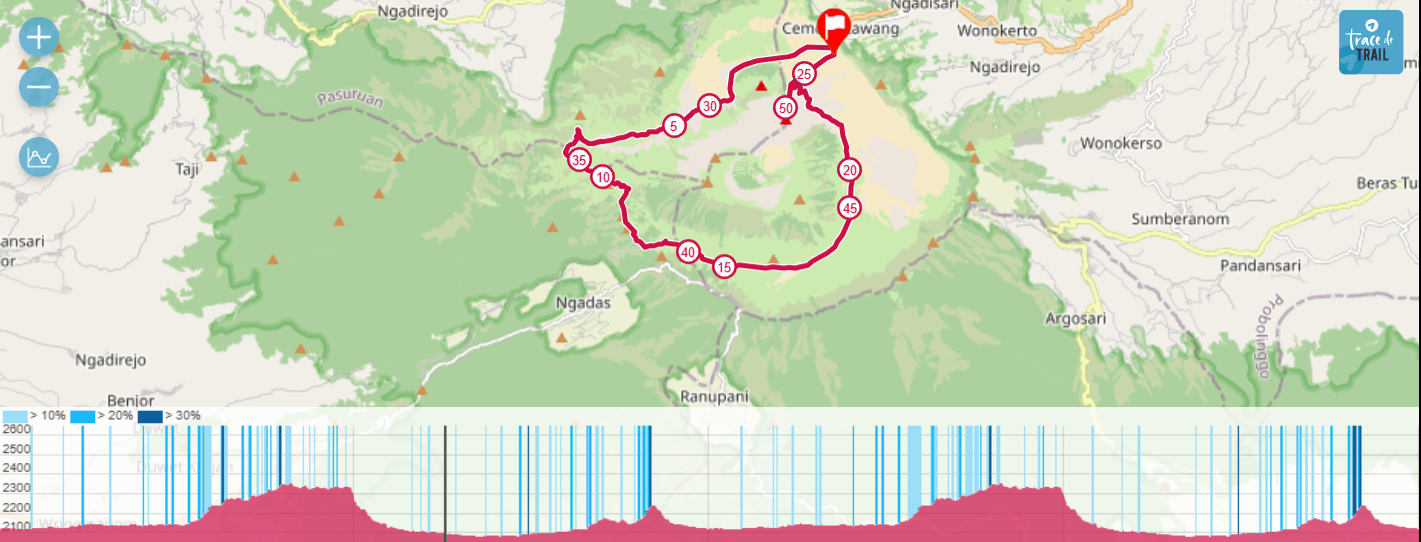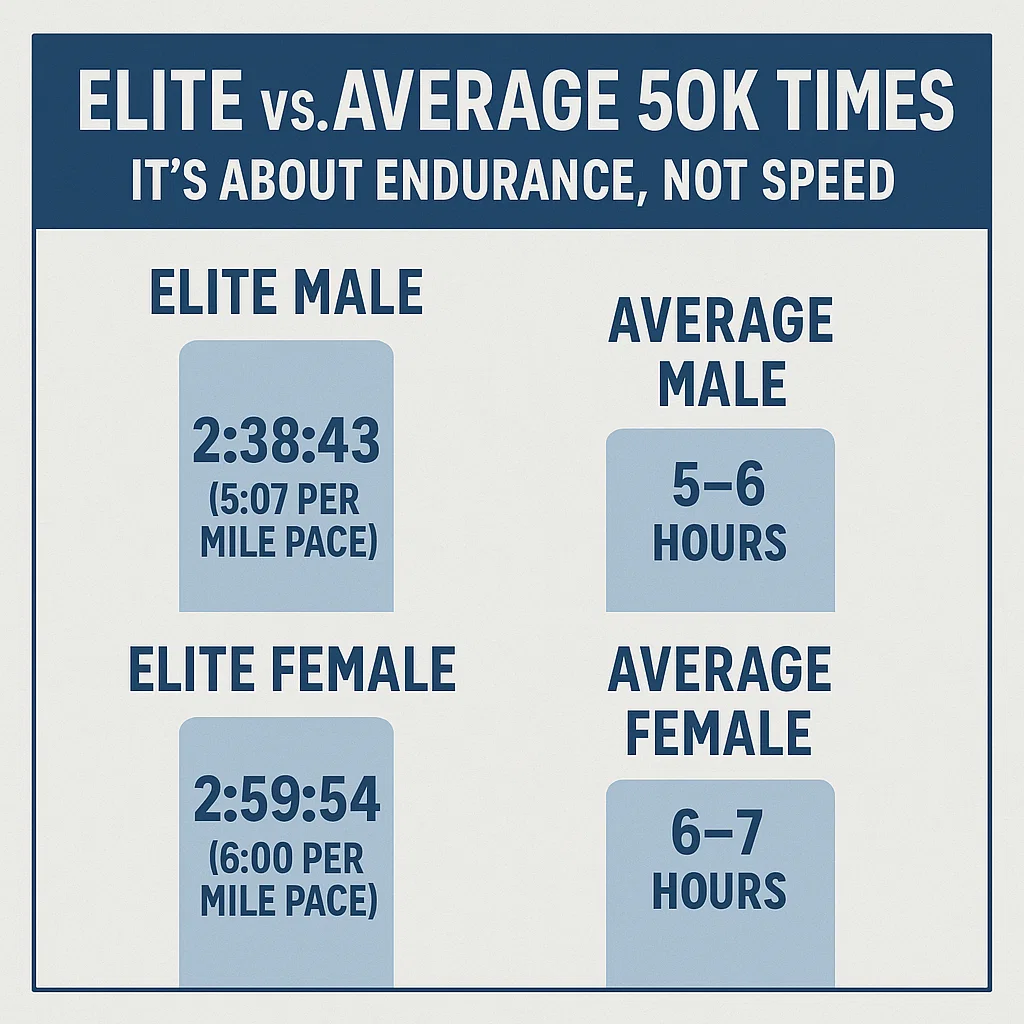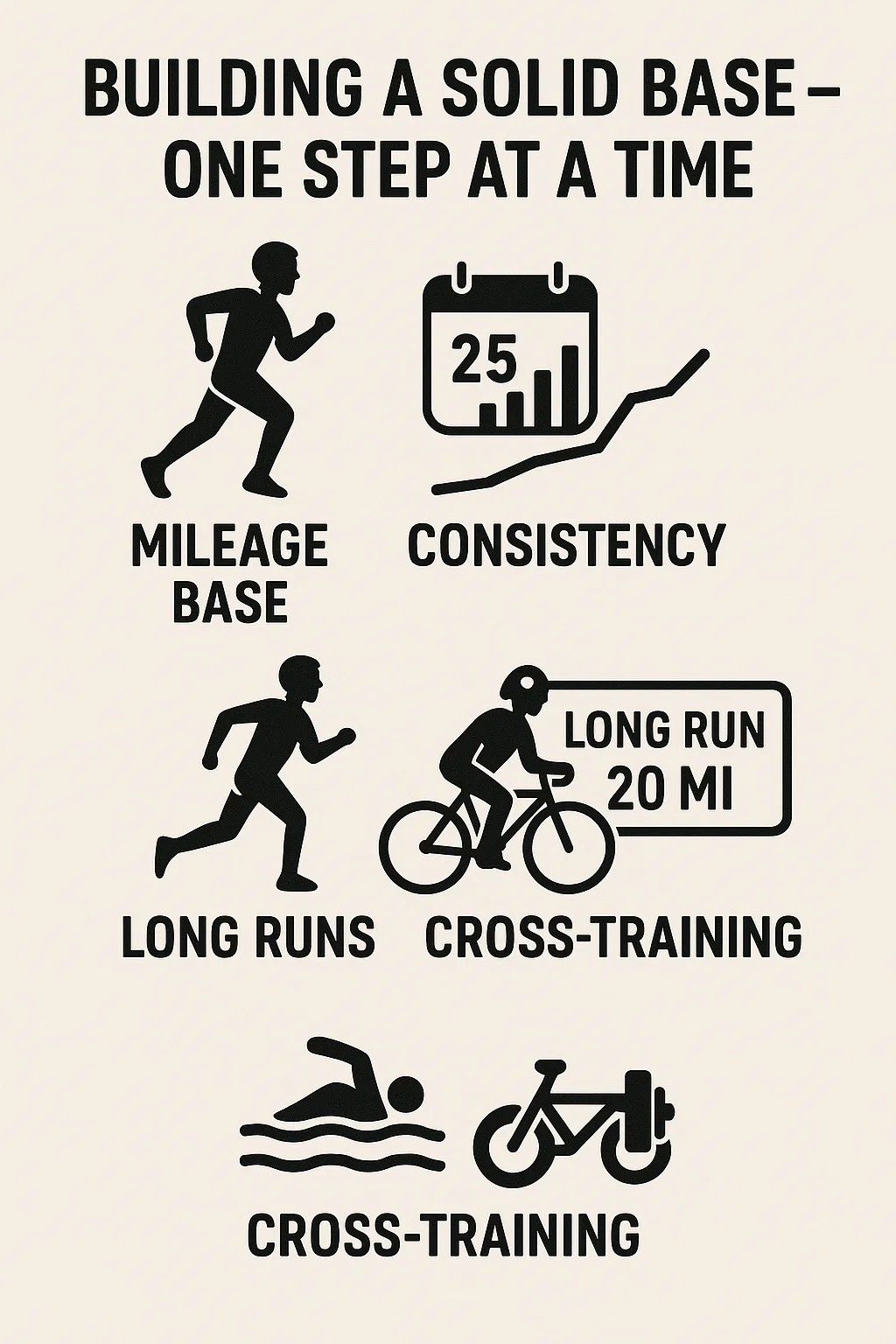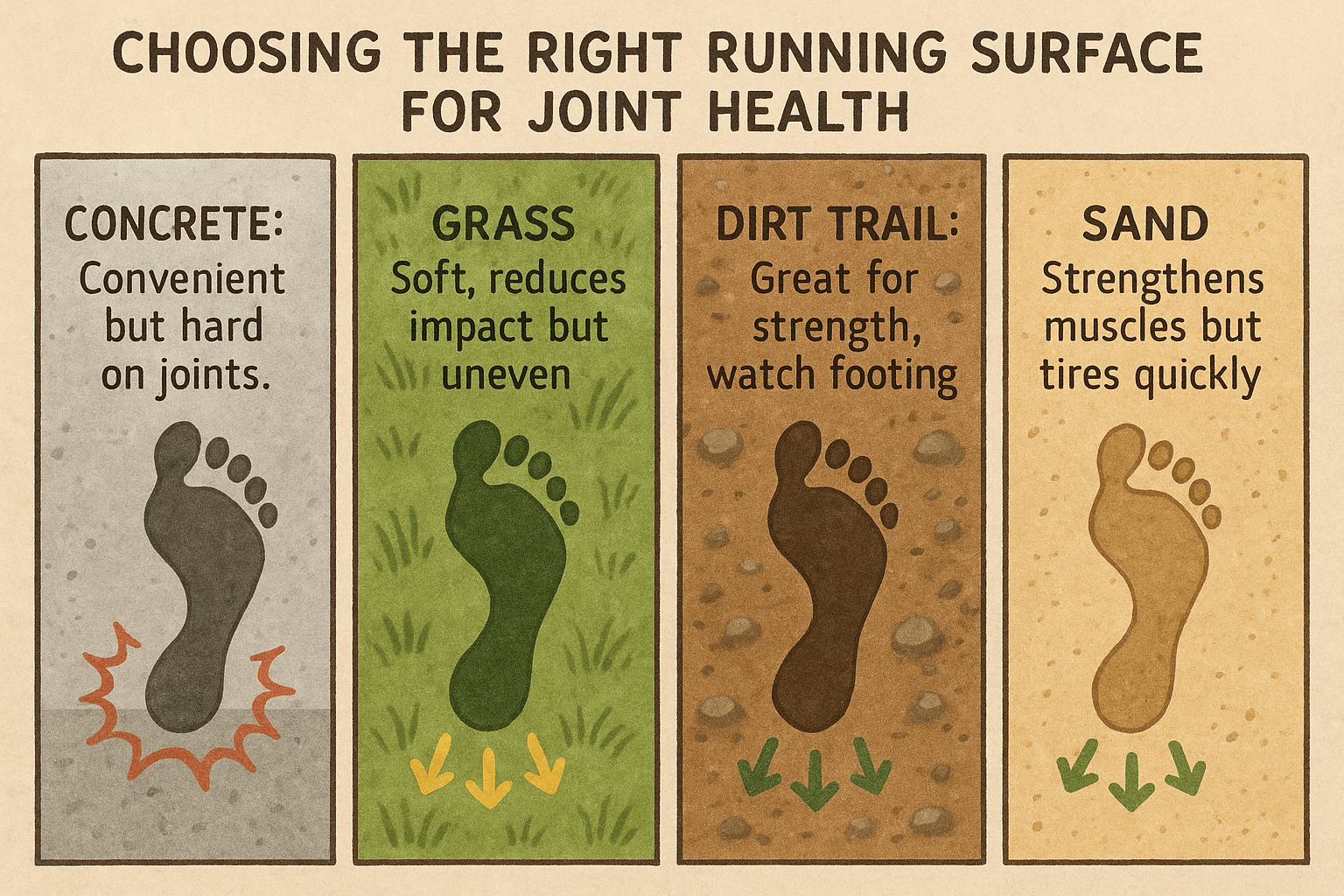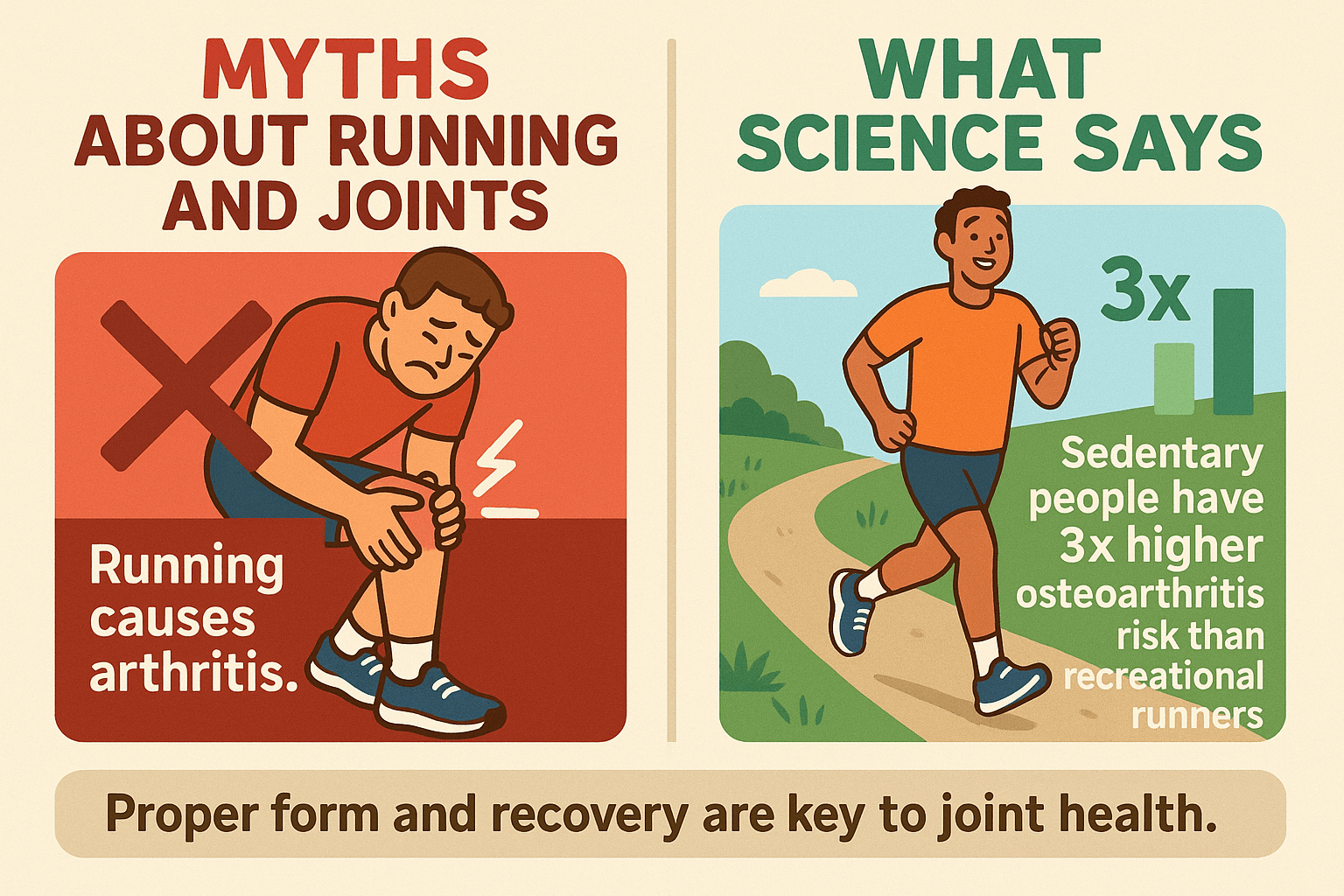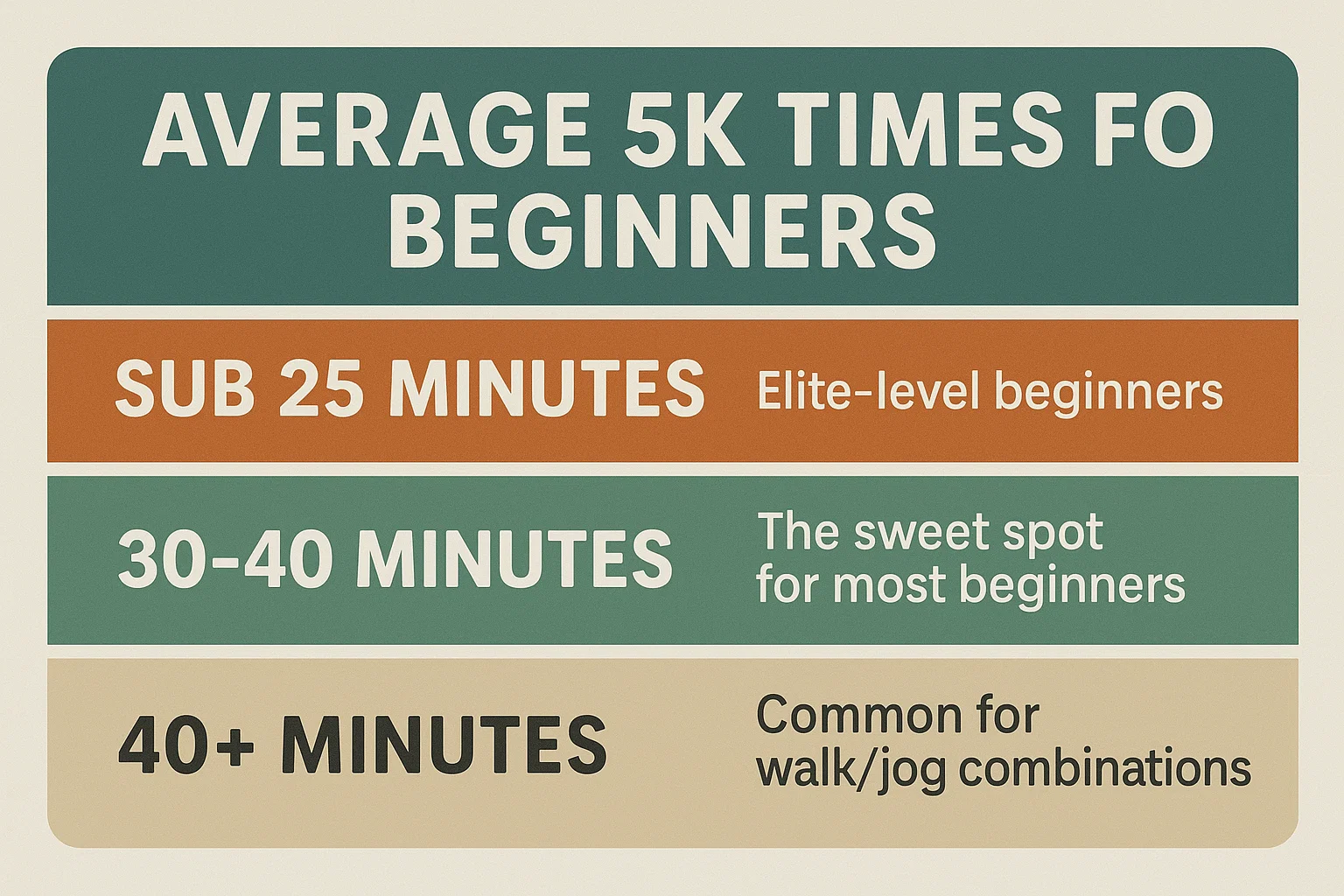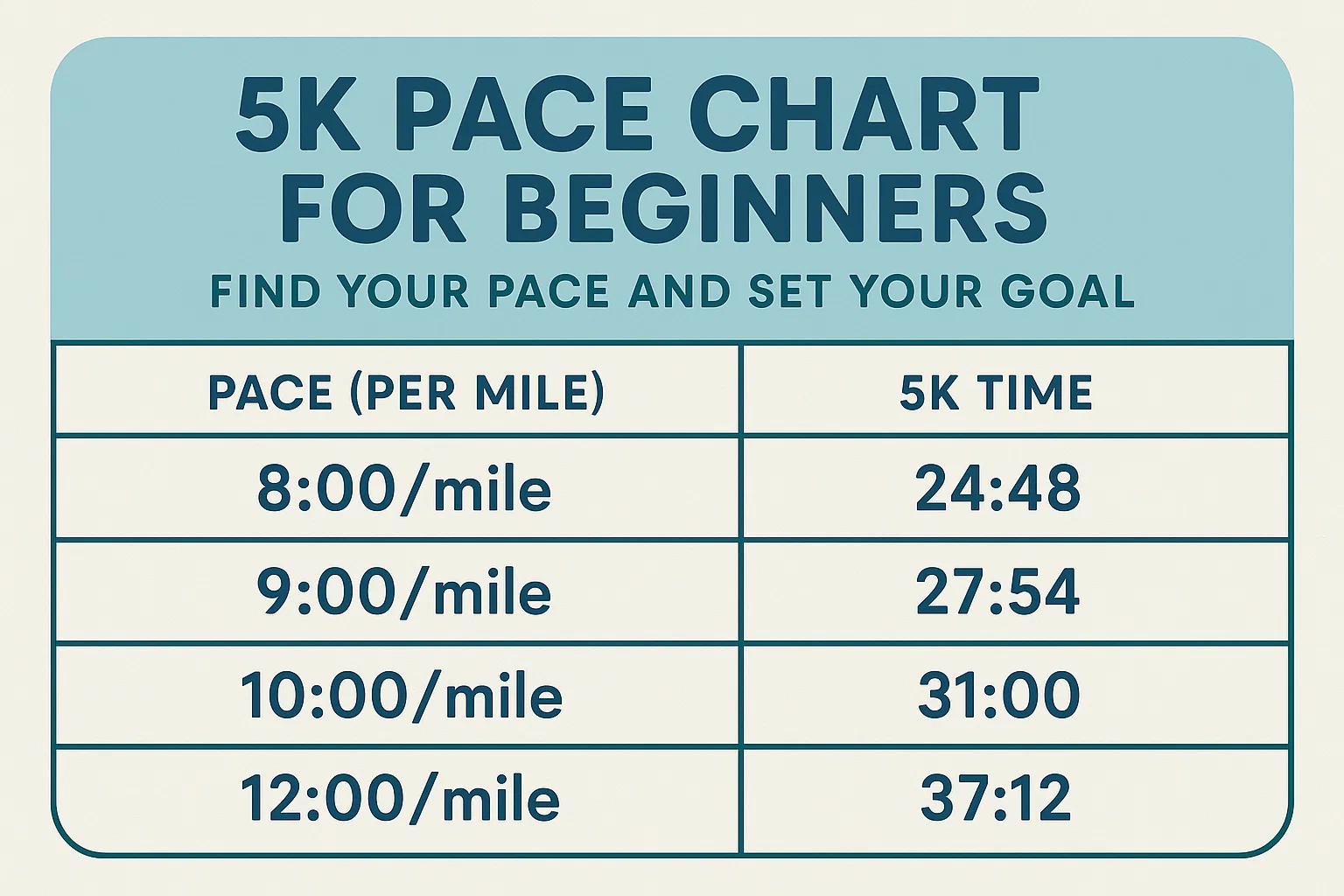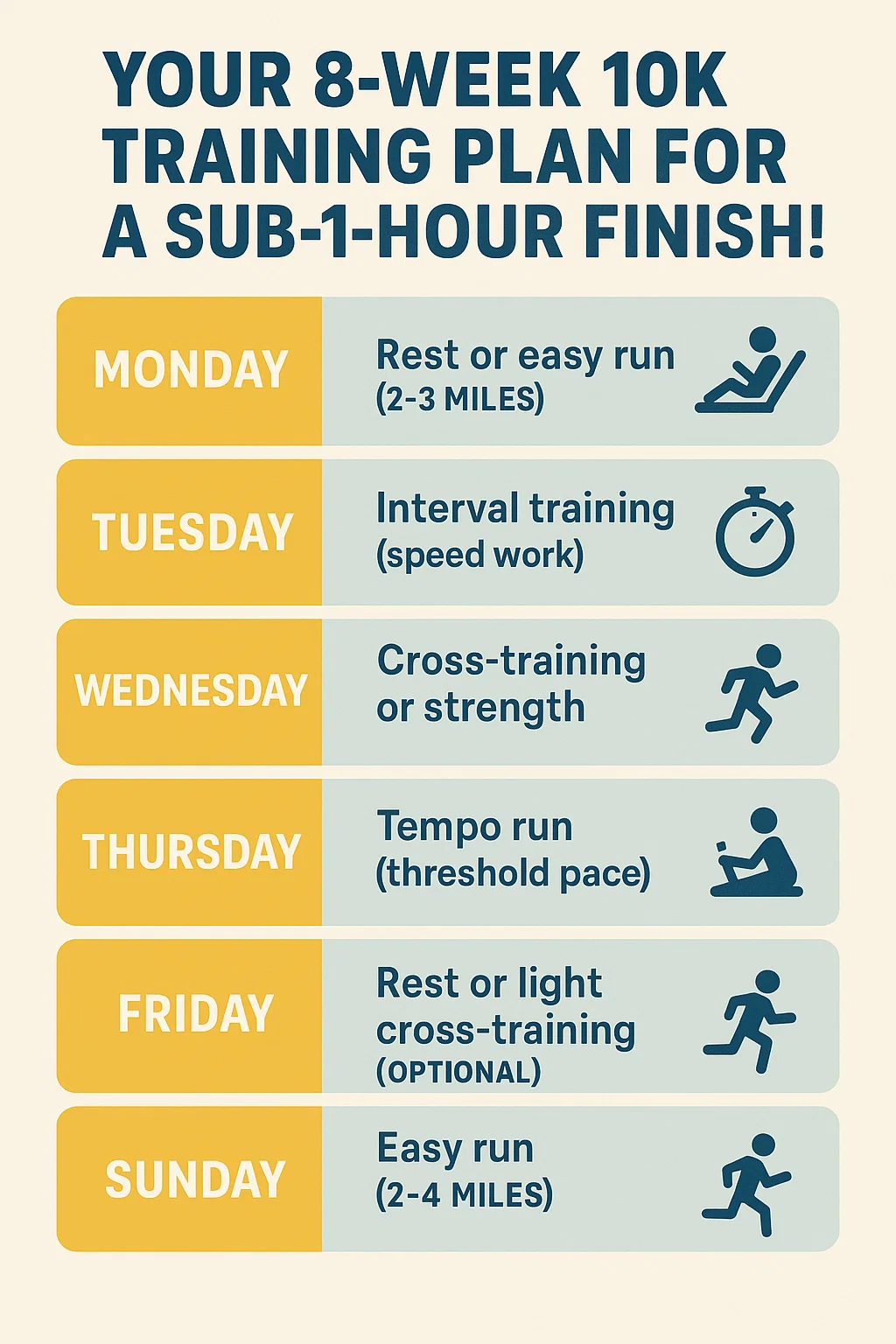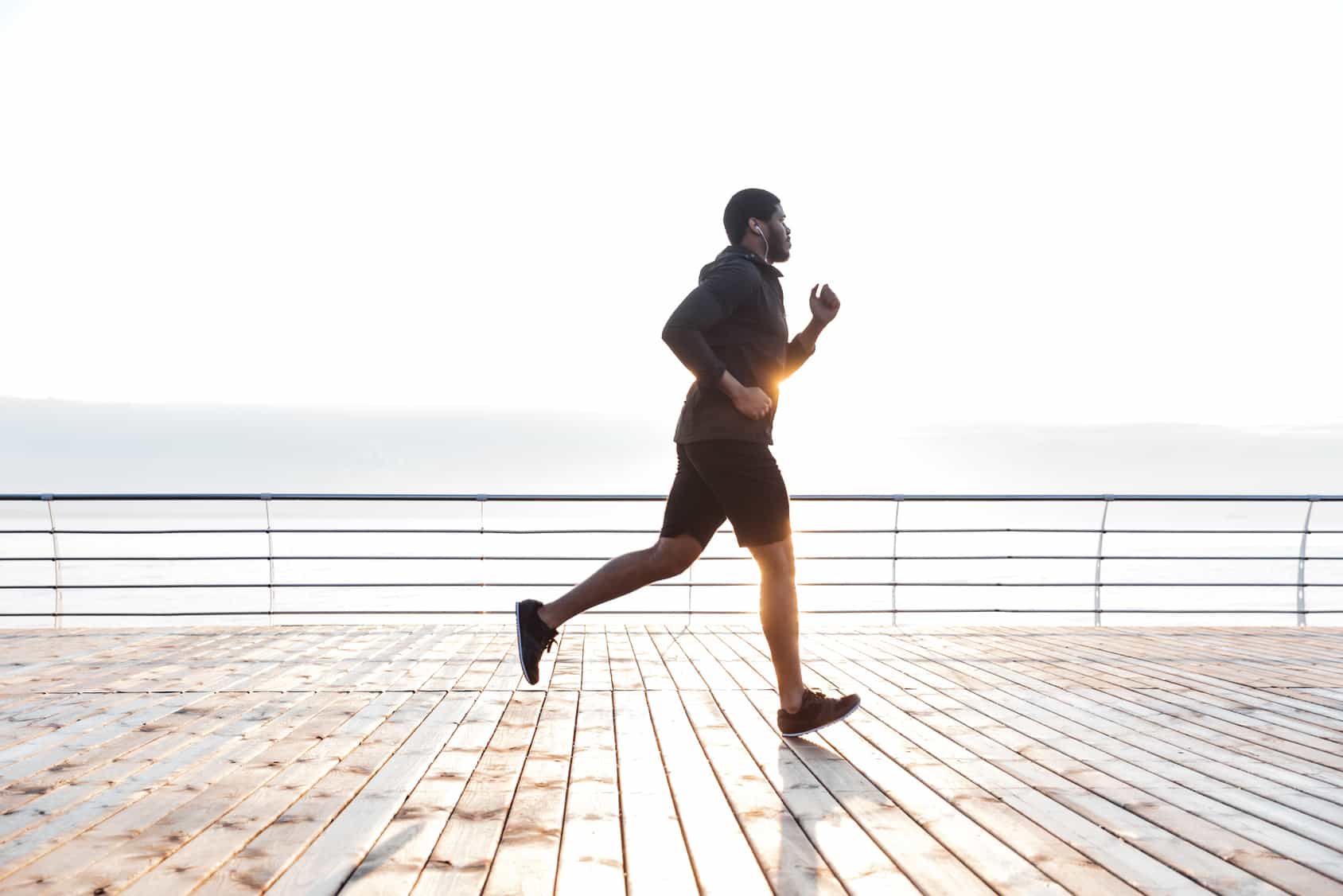In this guide, I’ll give you the lowdown on everything from training tips to nutrition, gear, and mental strategies. And of course, I’ll throw in a few personal stories, like my Bromo Desert adventure and the wild midnight start at the CTC 50K Ultra.
Let’s get to it!
What Is a 50K Ultramarathon?
Let’s start with the basics.
A 50K is an ultramarathon, which is just a fancy way of saying it’s any race longer than a 26.2-mile marathon.
In miles, that’s 31.07 miles.
It might sound intimidating, but trust me—50K is often the first ultramarathon distance that new ultra-runners tackle.
The “feel” at ultras is totally different from a road marathon.
Picture less of that ‘big city race’ feeling and more of an ‘adventure on the trails’ kind of vibe.
Many 50Ks are run on trail courses, which means you’ll probably be jogging up mountains, sloshing through mud, and hopping over roots or scrambling across rocks.
Let me explain what I mean…
Not yet ready for an ultra? Try my marathon plan.
Trail vs. Road Challenges
Now, if you’re coming from road marathons, here’s the kicker: trail ultras are a whole different beast.
Road marathons are usually spot-on in terms of distance and pace. Aid stations hand out gels and water every few miles.
In trail ultras, things get… wild.
A “50K” might actually turn out to be closer to 55K or 56K. Surprise, right? And the terrain? It can slow you down big time.
Take my experience in the Bromo Desert Marathon 50K, for example. Instead of running on smooth, flat roads, I found myself tackling volcanic sand dunes and steep climbs at high altitude.
One minute, I was running, and the next, I was power-hiking up a freaking crater! Trail ultras often demand that you slow down or even take hiking breaks—especially on those steep uphills.
And that’s totally fine! Walking breaks? Yeah, they’re actually part of a smart 50K strategy. That’s why ultra trail runners are often dubbed power walkers – we do more walking than running, truth be told.
The trails are unpredictable—rocks, mud, rivers, crazy weather. You’ve got to be ready for anything. But that’s what makes ultramarathons so much fun—just the adventure of it all.
Elevation = Extra Challenge
Let’s talk about elevation for a second. Many trail 50Ks come with some serious vertical gain. We’re talking hills, hills, and more hills. And it can make a HUGE difference in your race.
Here’s a trick: for every 100 meters of climbing, you can think of it like adding a whole kilometer to the effort. So, if you’re doing a 50K with tons of elevation, it could feel like running a much longer race.
During my Bromo Desert 50K, I had almost 1800 meters of climbing. Compared to other events, the elevation isn’t too much but for a first-timer, I’d to be careful and pick a a beginner-friendly ultra event (more on this later).
And it took me hours longer to finish than it would have on a flat course.
But that’s the deal with trail ultras—terrain and elevation make all the difference, so don’t worry too much about pace. The goal is to keep moving and take in the scenery. It’s all part of the experience.
To give you an idea, here’s the course profile for the bromo 50K event:
P.S Yes, that’s me being featured on the main page of the website. Famous right? Na. Just by accident
50K Race Times: World Records and Average Joes
Now, you might be wondering—how fast can 50K runners really go? Let me tell you, the pros make it look easy (even though it’s anything but). The men’s 50K world record? That’s CJ Albertson, who ran it in 2:38:43—31 miles at a crazy-fast 5:07 per mile pace! And for the women, Desiree Linden set the record at 2:59:54—she was the first woman to break 3 hours for a 50K. That’s insane!
But let’s be real here, that’s elite level. For most of us regular folks, a 50K is gonna take a lot longer than that. A solid amateur might finish in 5 to 6 hours on a good day.
Most people? They’re looking at finish times in the 6 to 7-hour range. And that’s totally okay! In fact, most 50Ks have 8-10 hour cut-off times, and plenty of runners take the full time to finish.
And here’s a fun fact: ultramarathons? Experience counts for a lot. Peak performance for a 50K tends to hit around 39-40 years old. So even if you’re not in your 20s, there’s a good chance you’ll be getting faster as you age!
P.S. Please keep in mind that these world records were performed on road, usually on indoor tracks. Not your typical trail course with elevation and treacherous terrains.
Trail vs Road Times
If you’re coming from marathons, expect to be slower in a 50K. It’s normal to run each mile 10 to 30 seconds slower than your marathon pace, even on a good day.
For example, if you run 8:00 minute miles in a marathon, your 50K pace might fall around 9:00-10:00 per mile.
That might add another hour or so to your time.
If the trails are technical or hilly, add more time to that.
For my first 50K took me about 8 hours, even though I had run a 3.5-hour marathon before. The sandy dunes, the slippery hills, the scorching heat and the mental aspect of running beyond 26.2 miles made it a whole new challenge.
Remember this: in ultras, it’s not about finishing fast. It’s about finishing strong.
Don’t stress about your time. As a first-timer, the main goal is to get across that finish line with a smile on your face.
And hey, sometimes being on the trail longer just means more time to fuel up, enjoy nature, and soak it all in.
Training Principles for a 50K Ultramarathon
Training for a 50K is a lot like marathon training, but with a few extra challenges thrown in.
The main things you need to focus on are building your endurance (lots of mileage and those long runs), running on terrain that matches race day, taking recovery seriously, and getting used to being out there for hours.
Let’s break it down into some solid principles.
Build Your Mileage Base (Consistency is Key)
To finish 31 miles, you need to have a solid base.
This isn’t about cramming in a few massive workouts. It’s all about consistency.
Start slow and build up gradually. Think of it like this: the more time you spend running, the more you teach your body and mind to handle the long hours on the trails.
Before your 50K, aim to reach a peak mileage of 50-60 miles per week. This isn’t a one-week wonder — it’s about steadily increasing your mileage until your body is ready to handle it.
If you’re just getting started and are newer to running, it might take up to a year of steady training.
But if you’re already running around 40 miles a week, six months of focused ultramarathon training should get you there.
Don’t stress about speed work for your first ultra. Throw in some strides or tempo runs for variety, but the real focus is just time on your feet.
One ultramarathon coach put it this way: “A 50K is a slower marathon.” The basic principles are the same as marathon training, but your focus should be on time on your feet, handling terrain, and fueling during those long runs.
My best advice?
Your first goal for a 50K? Simple — just finish. Forget about setting time goals. Your main focus is building that base and staying healthy. The biggest mistake I see in rookies is ramping up miles too quickly and ending up injured or burned out. Stick to the classic “10% rule” or listen to your body — increase gradually, and don’t forget to take recovery weeks when needed.
The Long Run
Long runs are your bread and butter for ultramarathon training.
They’re going to feel like your best friend and, at times, like a challenge you want to throw out the window. But no matter how hard they get, these long runs teach your body how to keep going when it feels like it can’t.
For marathons, long runs peak around 20 miles, but for a 50K, you’re going to stretch that further.
Aim for your longest run to be between 20 and 26 miles. Some plans even recommend running a full marathon as part of your training. But honestly, hitting 20-22 miles is plenty, especially if you’re doing back-to-back long runs (more on that later).
When I was gearing up for the CTC 50K, my longest training run was 24 miles on trails, and it took me nearly 5 hours.
It was exhausting, but it gave me serious confidence: “Okay, I can handle being on my feet for hours.” Those first long runs will break you down, but they’ll build you up too.
I’d break the run into mental chunks: “Just get to the next mile,” “Make it to the top of this hill,” “Just reach the next water stop.” It made those long, grueling hours feel a little more manageable.
Back-to-Back Runs:
One trick I used in my training was back-to-back long runs.
For example, I’d do a long 18-mile run on Saturday and then follow it up with 10-12 miles on Sunday.
It was tough at first, but it simulated running on tired legs — which is basically what an ultra feels like. A good rule of thumb from coaches is to get in 30-40 miles over two days when you’re training for a 50K.
That one weekend where I did 20 miles on Saturday and 12 miles on Sunday really changed my mindset.
Sunday’s run was tough at first, but I realized I could still keep going on tired legs — a huge confidence boost for race day because when you hit that halfway point in an ultra, your legs are already begging you to stop.
Train on Terrain (Hills & Trails are a Must)
If you’re training for a 50K trail race, here’s a piece of advice that’ll make all the difference: train on terrain that’s as close as possible to your race.
If your race has mountains, then find hills.
If it’s a technical trail, look for some gnarly paths to run on.
Running on trails isn’t the same as pounding pavement—it’s a whole different ball game.
You’ll be using muscles you never knew you had (I’m talking about those stabilizers and your ankles). It’s tougher, and your body’s going to feel it, so it’s important to get it used to the challenge.
When I was gearing up for Bromo, I didn’t just run any trails—I sought out the steepest, most challenging ones I could find. I even did hill repeats on a local trail until I was crawling up it.
But you know what? That paid off big time on race day when I faced those endless climbs. Train the way you race—it makes all the difference.
Now, let’s talk hills. When you’re facing big climbs in training (or race day), hiking is completely fine. In fact, it’s often the best way to get up those steep sections without burning out.
During my second ultra, the CTC 50K, the hikes were much more brutal. During the event, my mantra became: hike the ups, run the flats and downs.
Whenever I saw a big hill coming, I gave myself permission to power-hike it.
Guess what? I passed a lot of folks who tried to run up those hills, only to blow up halfway.
And don’t forget to train for those “extras” you might encounter on race day: running in the dark (ever tried a night run with a headlamp? If your race starts early or like CTC, at 10 PM, this is a must ), running in the heat, or even training in sand if your race happens in the desert. The more familiar race day feels, the better.
If you’re running a flat road 50K, don’t worry about the major elevation training, but still try to get in some soft-surface runs. You want to reduce the pounding on your legs. And yes, make sure you’re doing some long runs on flat pavement so your legs get used to that constant repetitive motion. You’ll need it come race day.
Recovery: Rest Hard, Run Hard
Let’s face it, ultra training is no joke.
It’s tough on your body. As you increase your mileage and long-run distance, recovery becomes just as important as the training itself. You’re pushing your muscles, joints, and even your immune system to the limit, so you need to prioritize rest just like you do with your runs.
Here’s what I’ve learned about recovery that keeps me coming back stronger:
- Sleep: Aim for 8+ hours of sleep per night. Your body does most of its repair work while you’re asleep. I always treated sleep like it was part of my training. Honestly, it’s the easiest “workout” ever. All you have to do is nothing, and your body gets stronger for it.
- Rest Days: Take at least one or two rest days a week. No running, no excuses. Let your legs fully recover. If you need to move, go for a gentle walk or do some stretching or yoga. But don’t push it on rest days.
- Listen to Your Body: If something feels off or you’re dealing with a nagging pain, don’t just push through it. Take a step back if you need to. I learned this the hard way after running through Achilles pain. I had to take an unplanned week off, and it wasn’t fun. Now, I respect rest like I respect my longest runs.
- Nutrition for Recovery: After those long runs, you need to refuel. Your body needs protein and carbs to rebuild those muscles. For me, a big smoothie or a solid meal always hits the spot. My go-to recovery snack is chocolate milk and a turkey sandwich—simple, but it works every time.
Put It All Together: A Sample Week
To give you an idea of what a peak training week might look like for a 50K, here’s what it could look like:
- Monday: Rest or easy cross-training (yoga, cycling, etc.)
- Tuesday: 5-mile easy run
- Wednesday: 8-10 mile run (moderate pace, maybe add in some hills or tempo work)
- Thursday: 5-mile recovery jog (super easy pace)
- Friday: Rest day
- Saturday: Long run – 20-22 miles on trails, go slow, and practice fueling
- Sunday: Second long-ish run – 10 miles easy (on tired legs from Saturday)
This comes out to about 50 miles for the week. The next week, you might cut back for a “down week” to recover, then build back up again. Everyone’s plan will vary, but the key parts are: one long run, maybe a back-to-back, and mostly easy-paced running.
Training for a 50K isn’t just about logging miles. It’s about listening to your body, training smart, and putting recovery just as high on the list as the running. You’ve got to run hard, but you’ve got to rest hard, too.
Hydration
Start early when it comes to hydration. Drink consistently throughout the race, not just when you’re thirsty. I made this mistake early on, but it’s especially important if it’s hot, like it was during my Bromo Desert 50K, where temps hit 30°C (86°F). I drank about 500-750 ml of water per hour and carried electrolyte tablets to avoid dehydration and cramping.
But here’s the key: Don’t overdo it. Too much water can actually be harmful. There’s something called hyponatremia, and you definitely don’t want that. So, listen to your body. Drink when you’re thirsty, but don’t drown yourself. Keep sipping, stay ahead of your hydration, and you’ll be good.
Practice Your Fueling in Training
The best time to figure out your fueling strategy is during your long runs. I practiced with gels, bars, and electrolytes every 30 minutes during a 20-mile training run. By the time race day came around, I knew exactly what my stomach could handle. And trust me, there’s nothing worse than trying to figure out your fueling plan during a race.
Test everything during training. Your body will thank you when race day comes around.
Gear Essentials: What You’ll Need for a 50K
Gear can make or break your race. After my first ultra, I knew exactly what I needed to feel comfortable and get through the race. Here’s the gear I swear by:
- Trail Running Shoes: You need the right shoes for grip and support on rocky, uneven terrain. Don’t make the mistake of showing up with shoes that aren’t broken in. Trust me, you don’t want blisters on race day.
- Hydration Pack or Belt: You’ll need to carry your own water and snacks. Aid stations might be spaced out, so a hydration vest or belt is your best friend.
- Headlamp: If your race starts early or ends late (like my CTC 50K did), you’ll need a headlamp to see where you’re going.
- Clothing: Moisture-wicking clothes are a must. You want to stay dry, not drenched. Bring a jacket or vest just in case the weather changes.
- Electrolyte Supplements: I always carry electrolyte tablets to keep my sodium and potassium levels in check. These really help prevent cramps.
Don’t forget a small first-aid kit, sunscreen, and chapstick. Trust me, those little things go a long way on race day.
Start Slow, Finish Strong
Here’s something I can’t stress enough—start slow. I know the race day excitement makes you want to go fast, but ultramarathons aren’t sprints. When I ran my first 50K, I took it easy at the start, and it paid off. I didn’t burn out in the first half, which gave me enough in the tank to pick up the pace later.
On the downhills, push the pace. On the uphills, take it slow—don’t be afraid to hike. It’s all about pacing. The key to finishing strong is managing your effort. Walk when you need to, and make sure you’re not going too hard early on.
Remember my mantra: hike the ups, run the flats and downs.
Pace Yourself: “Be the Fastest Tortoise”
When you’re gearing up for a 50K, forget obsessing over mile splits like you would in a marathon. Here, it’s all about the effort. There’s this saying in the ultra world: “Be the fastest tortoise.” Start slow, and try to keep it that way. You’re not racing to set a record in the first few miles – you’re setting yourself up for the long haul.
Run by Effort, Not Pace
For me, trail ultras are all about listening to my body. Sometimes I wear a heart rate monitor, but it’s mostly about the feeling. I use RPE (Rate of Perceived Exertion) – if I can talk, I’m in the sweet spot. If I’m gasping for breath, I dial it back. I want to save my energy for the long grind.
During my first 50K, I kept reminding myself: “If it feels slow, slow down some more.” I know, it sounds counterintuitive, but it works. During the CTC 50K, I saw a ton of runners take off like they were in a sprint, only to fade hard later.
I stuck to my plan, kept it steady, and ended up passing a bunch of those same runners in the second loop. Slow and steady? Definitely wins the race.
Pacing Mantras That Keep You Going
I’ve got a few mantras that keep me grounded on race day:
- “Your slowest pace matters more than your fastest.” This one’s big. You’re in it for the long haul, so don’t blow yourself out in the first few miles just to impress anyone. Keep it steady, and you’ll stay stronger longer.
- “Race the second half.” This one’s my favorite. I don’t push for speed until I’m well past the halfway point. In the first half, I let others zoom past. But come the second half? If I’ve still got legs under me, I start reeling people in. That’s when it’s really fun.
The Bromo Desert had two big loops, and I was pacing myself by walking the steep climbs and taking the downhills at a light shuffle. The first loop, I watched people zoom ahead, and I could feel the temptation to chase them.
But then I heard my coach’s voice in my head: “If it feels slow, slow down some more.” That advice saved me. By the second loop, I was passing runners who had started too fast.
Embrace the Ultra Mentality
Let’s face it: Ultras are mostly mental. While 50Ks might be 10% physical, that other 90% is all about your mind.
There will be moments when you’re feeling beat up and questioning why you’re out there. But this is where the mental game is won.
Here’s how I push through:
- Break it down into sections: Looking at the full 31 miles can be overwhelming. Instead, focus on small wins – the next aid station, the next gel, the next mile. I’ve done long runs where I just told myself, “Get to the next hill.” That’s all you need to think about.
- Positive self-talk: Sounds cheesy, but trust me, it works. I’ve used mantras like “One foot in front of the other” or “You’ve got this” when things get tough. I remember mile 28 during the Bromo Ultra – I was running on fumes, and all I could think was, “You didn’t come this far to only come this far.” It kept me going.
- Expect the lows, but know they’ll pass: There will be times when you feel like absolute garbage. But, just like life, things change. I hit a serious low during the CTC Ultra at 3 AM. The rain was pouring down, my headlamp failed me, my legs were wrecked, and I was exhausted. I told myself, “Just make it to the next aid station.” Once I got there, I had some hot Indomie (noodle soup), a little Coca-Cola (honestly, magic), and I was back on my feet.
Final Thoughts – You Can Do This!
Training for a 50K is a journey, no doubt. There’s no magic shortcut – just time, patience, and the grind. It’ll challenge you physically and mentally, but trust me, you’ll come out stronger than ever. Remember: it’s about consistency. Even when it sucks, just keep going. When you cross that finish line, you’ll know it was all worth it.
I’ll never forget the Bromo Desert 50K. I was nervous as hell at the start – doubts swirling in my mind. But once I settled into my rhythm, I was in the zone. I finished exhausted but proud, with a grin on my face. And honestly? It was one of the best feelings ever.
And you? Whether your goal is just to finish, or to crush it, your 50K will be one of the most rewarding experiences you’ll ever have. Let’s go – get out there and start training. You’ve got this.
Call to Action:
I want to hear about your 50K journey. Have you run one already, or are you gearing up for your first? Drop a comment below, and let’s support each other through this ultra journey. And if you found this guide helpful, share it with others who are thinking about their first 50K!
FAQ: Running Your First 50K
Q1: How many miles is a 50K race?
A 50K race is approximately 31.07 miles, making it just over a marathon distance.
Q2: Is a 50K considered an ultramarathon?
Yes! Any race longer than a marathon (26.2 miles) is considered an ultramarathon.
Q3: How should I train for a 50K race?
Gradually increase mileage with long runs, tempo efforts, and recovery days over several months. Back-to-back long runs and trail running (if relevant) are great additions.
Q4: How long does it take to finish a 50K?
Finish times vary depending on experience, terrain, and fitness. Most runners complete a 50K in 5 to 10+ hours.
Q5: Do I need to eat during a 50K?
Yes! Plan to fuel every 30–45 minutes with a mix of carbs, electrolytes, and fluids to keep energy levels stable.
Q6: Can I walk during a 50K race?
Absolutely! Walking is common, especially on tough climbs or technical terrain. Strategic walking can help manage energy.
Q7: What’s the difference between a 50K and a marathon?
A 50K is longer (31 miles vs. 26.2), often run on trails with more elevation and varied terrain, demanding more mental and physical endurance.
Q8: How many days a week should I train for a 50K?
Aim for 4 to 5 running days per week, including at least one long run and one rest or cross-training day.
Q9: What gear do I need for a 50K?
Key items include trail shoes (if off-road), hydration pack or bottles, nutrition, a hat or visor, and layered clothing for changing weather.
Learn More about Ultra-Distance Running
To dive a little deeper into the world of ultra-distance running, I’ve picked a few resources that can help:
- American College of Sports Medicine (ACSM): The ACSM offers a wealth of information on exercise science and training techniques. Their position stand on “Nutrition and Athletic Performance” provides evidence-based recommendations on fueling for endurance events, including ultra-marathons.
- UltraRunning Magazine: This publication is devoted to ultra-distance running and features articles, training tips, and interviews with experienced ultra-runners.
- Trail Runner Magazine: A great source for those focusing on trail running, which often overlaps with ultra-distance training. Their article on “Tips for Your First Ultra” provides practical advice for newcomers to ultra races.
- Running USA: This organization focuses on promoting and supporting the running industry. They often publish statistics and trends related to running events, including ultra-marathons.
- The North Face Endurance Challenge: The official website of this popular series of ultra-distance races includes a wealth of training resources, articles on endurance running, and nutrition tips. Check out their training resources here.

